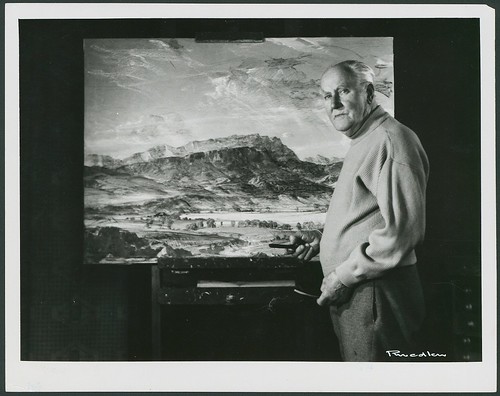The village of Hahndorf is located 28km south-east of Adelaide, in the region of the Adelaide Hills, South Australia. Hahndorf is Australia's oldest surviving German settlement.
The Peramangk People
Hahndorf was first occupied by the Peramangk Aboriginal people, a group which used scarification to mark passing through stages of life, as part of their
cultural practice. The Peramangk people called the area "Bukartilla" (after the local swimming hole).
 |
| Aboriginal man from South Australia, News (Adelaide, SA : 1923 - 1954), Saturday 16 December 1950 |
There are many rock art sites and documented Peramangk campsites along the Marne River. At Hahndorf,
the waterhole where the Peramangk taught their children to swim, still exists. Captain Hahn wrote:
".......a particularly large and deep waterhole
in the proximity of Hahndorf, in which the Aboriginal people liked to swim, and where they were in the habit of holding their song and dance performances."
Captain Hahn also recorded:
"I saw there a jacket which had been put together only from the skins of small opossums by an aboriginal woman. It was so beautifully sewn that few European women could do better. If you consider the tools with which the job was done, it deserves greater admiration. The thread had been made from kangaroo gut. A small bone sharpened to a point at one end served instead of a needle.”
“These people seem very good-natured, at least those living in the region of the Onkaparinga."
 |
| Aboriginal infants were often transported on the mother’s shoulders. Some Mothers of Other Lands (1938, May 5). News (Adelaide, SA : 1923 - 1954) |
Interestingly, Aboriginal groups to the east of the Mount Lofty Ranges were afraid of the Peramangk due
to their practice of circumcision. However, the Adelaide Aboriginal people feared the
Peramangk, as being as sorcerers, although they engaged in circumcising like themselves.
Both men and women received scars as part of initiation rites, and both Peramangk men and women passed through five different stages of life. Peramangk men generally had three tattoos across their shoulder blades, chest and upper arm, from incisions, or tattooing.
 |
| Aboriginal men with body scars, circa 1916 National Museum of Australia |
The Peramangk people also decorated many other things, such as the possum rugs they used to keep warm. Lines on the skin were made and darkened with powdered charcoal and fat, or with other colours. Similar designs as those decorating weapons were used, along
with representations of animals in outline.
Captain Hahn, who brought many German immigrants to South Australia, wrote in his diary:
"...The majority of Aboriginal people bear smallpox scars’. ‘Hair was dyed red and greased with fat.’ There were ‘more men than women.’ A white cockatoo feather in hair indicated that wearer was looking for a wife. Each group, of about 50, had their own burial grounds. All carried nets. Woomeras (spear throwers) were in use. They were generally peaceful around the Onkaparinga. There were few kangaroos in area probably as a result of over hunting because on Kangaroo Island there were thousands. Fire was used as a hunting method using a 20 mile diameter circle..."
An important Dreamtime
creation ancestor is Ngurunderi. The Dreamtime story below, featuring Ngurunderi, is part of today's long-term plan for the Coorong, Lower Lakes and Murray Mouth region:
"A long, long time ago Ngurunderi our Spiritual Ancestor chased Pondi, the giant Murray Cod, from the junction where the Darling and Murrundi (River Murray) meet. Back then, the River Murray was just a small stream and Pondi had nowhere to go. As Ngurunderi chased him in his bark canoe he went ploughing and crashing through the land and his huge body and tail created the mighty River Murray. When Ngurunderi and his brother-in-law Nepele caught Pondi at the place where the fresh and salt water meet they cut him up into many pieces, which became the fresh and salt water fish for the Ngarrindjeri people. To the last piece Ngurunderi said “You keep being a Pondi (Murray Cod).”
As Ngurunderi travelled throughout our Country, he created landforms, waterways and life. He gave to his people the stories, meanings and laws associated with our lands and waters of his creation. He gave each Lakalinyeri (clan) our identity to our Yarluwar-Ruwe (country) and our Ngartjis (animals, birds, fish and plants) – who are our friends. Ngurunderi taught us how to hunt and gather our foods from the lands and waters. He taught us, don’t be greedy, don’t take any more than you need, and share with one another." (
1.)
The Lutherans
Lutheran immigrants, escaping religious persecution, established the village of Hahndorf after arriving in Australia in December 1838. The ship, which brought out the 38 families from Prussia, was called the Zebra and its captain was a Dane, named Captain Hahn.
Captain Hahn, during the long voyage, had become impressed with the 187 Lutheran passengers on his ship, and he resolved to help the group get established in the foreign land. Adelaide was only four years old at the time, with few facilities and little infrastructure. However, as Captain Hahn could speak English, he was able to negotiate a lease on 60 hectares of land, set not far from the River Torrens.
 |
Captain Dirk Meinertz Hahn |
The immigrants could not afford to have their goods t
ransported from the ship, at Port Adelaide, known at that time as Port Misery, so they
carried their belongings, or, used handcarts during the two months it took to reach the place where they would build their village.
In honour of the Danish sea captain, they named the town Hahndorf (Hahn's village). The first winter, however, was very difficult and some died from hunger.
Within five years, the Lutheran migrants were doing well, with agriculture and a mill established, as well as an inn, a general store and various trades.
A German-style
village was established, with some half-timbered buildings (fachwerk) and a vineyard was planted. Small businesses began to prosper in the main street and Hahndorf became an important supplier of fresh fruit and vegetables to Adelaide.
The original German Arms Hotel was located opposite today's, German Arms Hotel, at 80 Main Street in 1839. It was the first licensed hotel in Hahndorf.
Church and School
Hahndorf Lutheran Church (St. Michael's), was completed in 1840. St Paul's Church was erected in Windsor Avenue in 1858. Doctrinal differences in 1846, between Pastor Kavel and Pastor Fritzche resulted in Hahndorf's
population dividing into two separate Lutheran churches. A new St Paul's Church was built in 1890.
 |
| Hahndorf Lutheran Church (St. Michael's), was completed in 1840. Chronicle (Adelaide, SA : 1895 - 1954), Thursday 2 February 1939 |
 |
| St, Paul's Church, Hahndorf, SA, Chronicle (Adelaide, SA : 1895 - 1954), Thursday 2 February 1939 |
The Luthern settlers established a school in 1839, with F Kavel, as teacher. At first, lessons were held outside, then inside a hut, until a room in a house at 62 Main Street, was used as a "teacherage".
In 1854 TW Boehm was the teacher at the Lutheran School attached to St Michael’s Church. However, Boehm had a disagreement with church elders over religion being taught at the school, as public schools supported by government money were not permitted to have religious instruction.
So Boehm opened his own school, in September 1857, supported by government funds, following the curriculum, without religious instruction.
 |
| Traugott Wilhelm Boehm (18 October 1836 – 12 May 1917) was a schoolmaster, founder of the German School in Hahndorf, SLSA |
Carl Friedrich Adolph Strempel (1831-1908). who was born in Prussia, became the pastor of the Hahndorf parish on 21 October 1855. In the following year, he was elected to the Church Council and was its secretary for forty years. On 5 May 1858, he married Marie Charlotte Friederike, daughter of Rev. H. Meyer of Bethany, South Australia.
 |
| The late Pastor Strempel, Observer (Adelaide, SA : 1905 - 1931), Saturday 1 February 1908, |
Aboriginal Warriors
In 1844, the German immigrants of Hahndorf witnessed a battle between warriors of the Permanangk and another tribal group called the Moop-pol-tha-wong, near the site of Nixon's Mill at Hahndorf. Mounted troopers arrived and dispersed the 2000 or so, Aboriginal warriors.
 |
| Nixon's Mill, Mount Barker, SA, Adelaide Observer (SA : 1843 - 1904), Saturday 9 August 1902 |
European ownership and land use were very different to that of Aboriginal people. Aboriginal people had lived at low densities, close to the land and the resources it provided. As a relatively large part of the Aboriginal diet came from hunting, larger areas of land were required, as animals may not be evenly distributed or easily found.
Ration Stations and Reserves were set up for Aboriginal people, scatted throughout the Mount Lofty Ranges; including the Mount Barker Council district, and including at least 3 known Government waterholes and 2 Legislated Reserves.
Some of the
original settlers moved away from Hahndorf by the 1850s. Some moving to Klemzig (now a suburb of Adelaide) and others to Lobethal (settled in 1842 by Prussian immigrants), or the Barossa Valley.
1880s
 |
Hahndorf General view of Hahndorf's main street. No known copyright restriction. Circa 1880.
|
 |
Stonemason at Hahndorf, SA, Bom Cemetery Stone Work, 1880s, SLSA
|
1890s
 |
| Evening Journal (Adelaide, SA : 1869 - 1912), Thursday 10 July 1890 |
 |
| Quiz and the Lantern (Adelaide, SA : 1890 - 1900), Thursday 20 October 1898 |
 |
| Cottage near Hahndorf, SA, 1890, SLSA |
1900s
 |
| School House, Hahndorf, S.A. - very early 1900s, Kaye |
 |
Thiele's store, Hahndorf Thiele's store at Hahndorf No known copyright restriction. Circa 1900
|
 |
| HAHNDORF FOOTBALL CLUB. PREMIER HILLS' FOOTBALL ASSOCIATION, 1904. Chronicle (Adelaide, SA : 1895 - 1954), Saturday 8 October 1904 |
 |
View of Hahndorf, SA, 1905
|
 |
| B. & R. Paech, Union Inn, Hahndorf, South Australia - very early 1900s, Kaye |
 |
| Hahndorf, S.A. - ery early 1900s, Notice the man up in the tree behind the telegraph pole. Kaye |
 |
| Railway men's ambulance competitions, at Ambleside, SA Observer (Adelaide, SA : 1905 - 1931), Saturday 8 November 1913 |
 |
| Wedding at Hahndorf, 1914, Photograph, taken outside a house, of a wedding group and a large number of wedding guests. Back of the photo inscribed: Wedding of Art Zilm and Clara Nitschke, April 16th 1914. Photographer is Nitschke, Hahndorf. State Library of South Australia |
WWI
 |
| Corporal C. W. Huf, elder son of Mr. and Mrs. C. Huf, late of Balhannah, is another of the Australians of German ancestry who have sacrificed their lives in the cause of justice in this war. He was born in Victoria, but educated principally in South Australia, at the Blumberg Lutheran School and the Blumberg and Mount Barker High, Schools. He enlisted as a member of the first contingent, and was 20 years of age. Of a quiet, unassuming disposition, he was highly esteemed. He was a grandson of Mrs. G. Promnitz, of Blumberg, and a nephew of Pastor Brauer of Hahndorf. His parents now reside in Sunbury, Victoria, Register (Adelaide, SA : 1901 - 1929), Saturday 29 May 1915 |
 |
| Douglas Austin Byard (19 June 1887 – 30 April~3 May 1915) enlisted in 1914, served as private with 16th Battalion of 1st AIF, killed at Gallipoli.Register (Adelaide, SA : 1901 - 1929), Thursday 22 July 1915 |
Anti-German Feeling
All Lutheran Schools, including the one at Hahndorf, were closed by an Act of Parliament in 1917, due to the anti-German feeling during WW1.
Hahndorf remained culturally isolated from the British and this
resulted in widespread anti-German sentiments during World War 1. Then in 1917, an Act of Parliament changed the name of the town to Ambleside and the general level of distrust against Germans led to some people anglicising their German names.
The Hahndorf Academy, was the second school to be established in Hahndorf. In 1919, the building was bought by Harry Hirte and converted into a maternity hospital run by Nurse Bertha Shmidtke. Later the building was turned into flats.
 |
| Began as the public school operated by teacher TW Boehm. Morphed into the hahndorf Academy, SA, Adelaide Observer (SA : 1843 - 1904), Saturday 2 May 1903 |
Artist: Hans Heysen
The German-born Australian artist, Hans Heysen, became a household name and by 1912, he had earned enough from his art to buy a property called "The Cedars" near Hahndorf, in Billy Goat Lane. He
built a studio which cost about 400 pounds, an extravagant amount in that day. Heysen used this studio from 1913 until his death 55 years later in 1968.
 |
| Hans Heysen painting, Hahndorf, Adelaide Hills, January 1950, photographer R. Donaldson, PIX Magazine, State Library of New South Wales, ON 388/Box 004/Item 006, State Library of New South Wales |
1920s
 |
| Hahndorf General view of Hahndorf . No known copyright restrictions. Circa 1920 |
Due to the First World War, the South Australian Government changed many German place names. In 1917 The name Hahndorf was changed to Ambleside.
 |
| CARNIVAL AT AMBLESIDE. (1928, October 6). Observer (Adelaide, SA : 1905 - 1931) |
1930s
 |
| Chronicle (Adelaide, SA : 1895 - 1954), Thursday 21 September 1933 |
 |
| Chronicle (Adelaide, SA : 1895 - 1954), Thursday 3 December 1936 |
 |
| Mail (Adelaide, SA : 1912 - 1954), Saturday 5 February 1938. Philately is the study of postage stamps and postal history |
First Woman to Win the Archibald Prize
Nora Heysen, born in Hahndorf in 1911, was an Australian artist and daughter of landscape painter Hans Heysen. She was the first woman to win the prestigious Archibald Prize in 1938 for portraiture and the first Australian woman appointed as an official war artist.
 |
| Photograph of Australian artist Nora Heysen by Harold Cazneaux |
 |
| Offical opening of the Pioneer Memorial Gardens, Hahndorf, SA, Chronicle (Adelaide, SA : 1895 - 1954), Thursday 2 February 1939 |
Hahndorf Rodeo
 |
| Chronicle (Adelaide, SA : 1895 - 1954), Wednesday 31 December 1947 |
 |
| Champion riders from many parts of Australia gathered at the annual Hahndorf Rodeo, Chronicle (Adelaide, SA : 1895 - 1954), Thursday 9 January 1947 |
Early Residents of Hahndorf
 |
| Group of early residents at Hahndorf.: left - right: G.van der Molen; Mr.& Mrs.van der Molen; Miss P.van der Molen; G.van der Molen;Miss B.Bratke. 1895 |
 |
| Johann Friedrich Wilhelm Zilm, 1895. His Lutheran family arrived on the Bengalee from Hamburg having fled their native Goltzen, a village near Brandenburg after religious persecution from Prussian authorities. They were involved with fifty other German families in the founding of Hahndorf. |
 |
| The Jaensch family settled in Hahndorf in 1839. J. Christian Jaensch Jnr. established one of Hahndorf’s first butcher’s shops, Observer (Adelaide, SA : 1905 - 1931), Saturday 28 January 1905 |

Chronicle (Adelaide, SA : 1895 - 1954), Thursday 29 April 1937
|
 |
OF 1838.Christoph Liebelt, Ch. Jaensch, Mrs. Ch. Jaensch, Mrs. Pade. Aged 84. Aged 81. Aged 76. Aged 76. This group of Pioneer Colonists arrived by tbe Zebra on December 28, 1838, when they settled at Hahndorf. Besides starting a Flour Mill at Hahndorf they were also the founders of St. Michael's Church there. |
 |
| Pioneer residents of Hahndorf: Johann Wilhelm Thiele, Johann Christian Liebalt, Christian Jaensch, Reinch von der Molen, Traugott Jaensch, Johann Carl Altmann. |
Around Hahndorf |
| Sam Trenorden Leathersmith Hahndorf South Australia. A half-timbered buildings (fachwerk.) |
 |
| Studio of Hans Heysen, "The Cedars". constructed from Hahndorf bluestone and Verdun freestone, SA. |
 |
| Old building in Hahndorf, SA |
 |
The Hahndorf Old Mill, circa 1854
|
 |
| Hahndorf, SA. The German Arms, built circa 1861 |
 |
| Street scene in Hahndorf, SA |
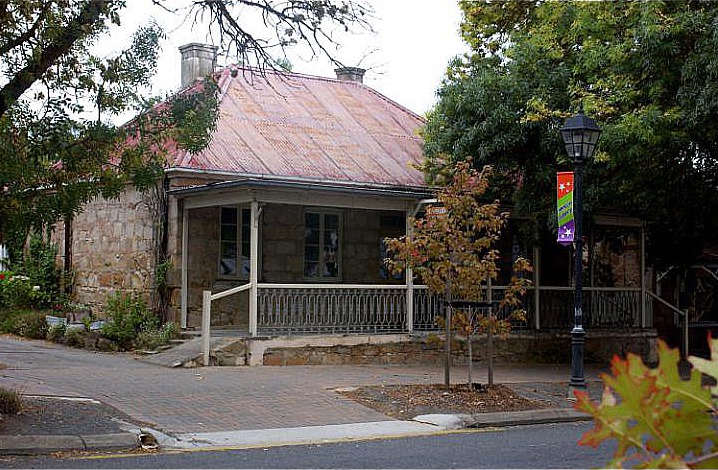 |
Detmold House the residence of the Wittwer family who established the local mill, Hahndorf, SA. Was built in 1861
|
 |
| Main Street Hahndorf, SA, an artillery piece from the Western Front. |
 |
Hahndorf Academy, circa 1857. Was a school now an art gallery, SA
|
 |
| 1839 Café at 56 Main Street, Hahndorf, SA |
 |
| Ye Olde Icecreamery and Café at 27 Main Street, Hahndorf, SA |
 |
| Rockbare Cellar Door at 102 Main Street, Hahndorf, SA |
 |
Originally opened in 1866 as Bom's Monumental Marble Works, Hahndorf, SA
|
 |
| Arts and Crafts shop in 36 Main Street, Hahndorf, SA |
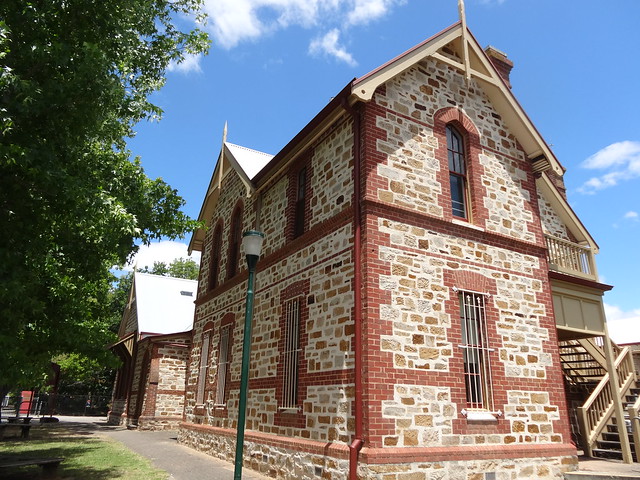 |
Handorf State School was built in 1879 denisbin, SA |
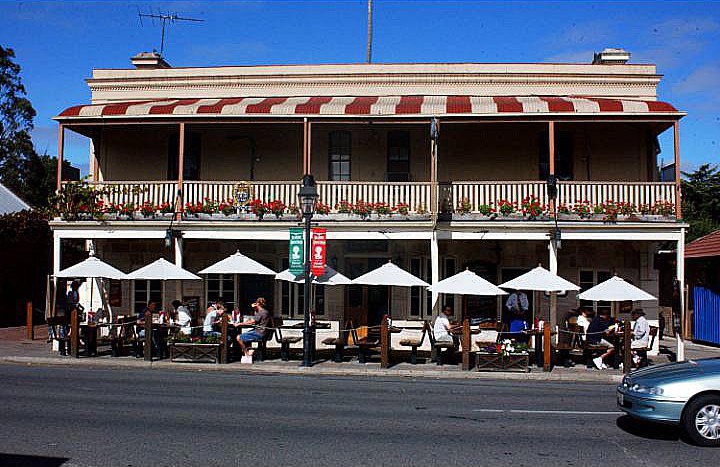 |
| The Union Hotel which was built in 1863, but has been operating as the Hahndorf Inn since 1972, SA |
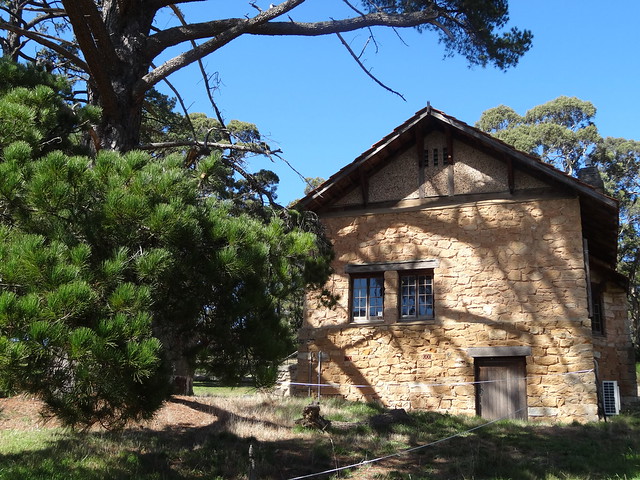 |
The art studio of Australian painter Sir Hans Heysen at the Cedars near Hahndorf, was erected in 1912 denisbin |
 |
| House at Hahndorf built in the 1850s in the German fachwerk style, SA |
 |
| Historic building, Hahndorf, SA |
 |
| St. Michael's Church in Hahndorf, South Australia. The oldest Luthern church in Australia, dating from 1858, SA |
 |
| Scene at Hahndorf, SA |
Things To Do and Places To Go

















